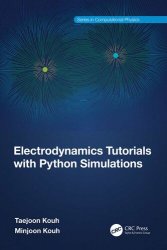Electrodynamics Tutorials with Python Simulations
- Добавил: literator
- Дата: 9-02-2024, 06:16
- Комментариев: 0
 Название: Electrodynamics Tutorials with Python Simulations
Название: Electrodynamics Tutorials with Python SimulationsАвтор: Taejoon Kouh, Minjoon Kouh
Издательство: CRC Press
Год: 2024
Страниц: 295
Язык: английский
Формат: pdf (true)
Размер: 35.5 MB
This book provides an accessible introduction to intermediate-level electrodynamics with computational approaches to complement a traditional mathematical treatment of the subject. It covers key topics in electrodynamics, such as electromagnetic fields, forces, potentials, and waves as well as Special Theory of Relativity.
Through intuition-building examples and visualizations in the Python programming language, it helps readers to develop technical computing skills in numerical and symbolic calculations, modeling and simulations, and visualizations. Python is a highly readable and practical programming language, making this book appropriate for students without extensive programming experience.
This book can serve as an electrodynamics textbook for undergraduate physics and engineering students in their second or third years, who are studying intermediate- or advanced-level electrodynamics and who want to learn techniques for scientific computing at the same time. This book will also appeal to Computer Science students who want to see how their computer programming skills may be applied to science, particularly to physics, without needing too much background physics knowledge
Perhaps the most challenging step in following the codes in this book may be the first step of getting started with Python. Fortunately, there are a few user-friendly options at this point of writing. The first option is a free, cloud-based Python environment like Google Colaboratory (or Colab). You can open, edit, and run Python codes on a Jupyter Notebook environment using a browser. The second option is to download and install a distribution of Python that already includes relevant packages, such as Numpy and Matplotlib, and other valuable tools, such as Jupyter Notebook. We recommend Anaconda Distribution, which supports different operating systems (Windows, iOS, and Linux) and makes it easy to configure your computer. The third option is to install each module and dependency separately.
Key features:
• Major concepts in classical electrodynamics are introduced cohesively through computational and mathematical treatments.
• Computational examples in Python programming language guide students on how to simulate and visualize electrodynamic principles and phenomena for themselves.
Скачать Electrodynamics Tutorials with Python Simulations
[related-news] [/related-news]
Внимание
Уважаемый посетитель, Вы зашли на сайт как незарегистрированный пользователь.
Мы рекомендуем Вам зарегистрироваться либо войти на сайт под своим именем.
Уважаемый посетитель, Вы зашли на сайт как незарегистрированный пользователь.
Мы рекомендуем Вам зарегистрироваться либо войти на сайт под своим именем.
